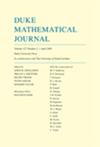对角线拉姆齐通过有效的准随机
IF 3
1区 数学
Q1 MATHEMATICS
引用次数: 36
摘要
我们将对角线拉姆齐数的上界改进为$k\ge 3$的\[R(k+1,k+1)\le\exp(-c(\log k)^2)\binom{2k}{k}\]。为此,我们建立了由Thomason引入并由Conlon扩展的Ramsey数的准随机和归纳框架,证明了关于图收敛的最优“有效准随机”结果。这种最优性代表了改进的天然障碍。本文章由计算机程序翻译,如有差异,请以英文原文为准。
Diagonal Ramsey via effective quasirandomness
We improve the upper bound for diagonal Ramsey numbers to \[R(k+1,k+1)\le\exp(-c(\log k)^2)\binom{2k}{k}\] for $k\ge 3$. To do so, we build on a quasirandomness and induction framework for Ramsey numbers introduced by Thomason and extended by Conlon, demonstrating optimal "effective quasirandomness" results about convergence of graphs. This optimality represents a natural barrier to improvement.
求助全文
通过发布文献求助,成功后即可免费获取论文全文。
去求助
来源期刊
CiteScore
3.40
自引率
0.00%
发文量
61
审稿时长
6-12 weeks
期刊介绍:
Information not localized

 求助内容:
求助内容: 应助结果提醒方式:
应助结果提醒方式:


